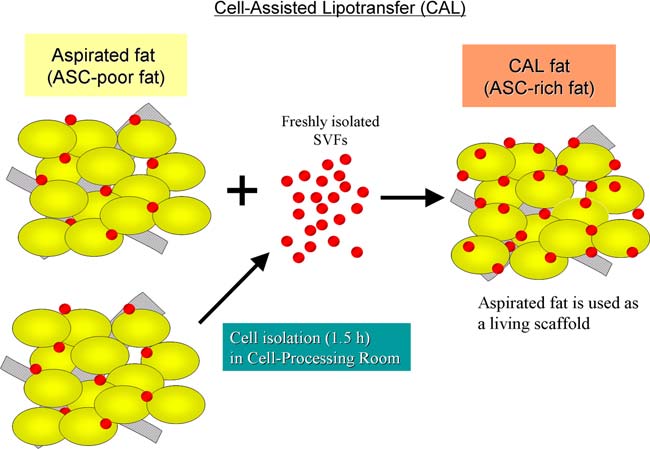BUILDING BETTER BREASTS
Stem Cell Techniques in Breast Augmentation
Why Bigger Breasts?
Tissue Engineering
Stem Cells & Breasts
Future Directions
References
Stem Cells and Breasts
The breasts are perfect candidates for the use of stem cells for regenerative therapy. Previously, fat grafts have been used to augment the size and shape of the breast and have been shown to be effective and safe for women. They fell out of favor due to a 1987 paper from the American Society of Plastic and Reconstructive Surgeons which condemned its use due to a perceived decrease in breast cancer screening efficacy, which was shown to be unfounded [5]. This paper shows that autologous grafts can be and are effective for breast augmentation and the surgeries performed pave the way for the next generation of breast augmentation: adipose-derived stem cell therapy coupled with fat grafting in the breast.
Cell-Assisted Lipotransfer[6]
In cell-assisted lipotransfer, adipose cells are harvested from the patient and split into two sections. In one of the sections the stem cells are harvested (adipose-derived stem cells) and the adipose tissue is otherwise discarded. The isolated stem cells are then added to the other half of the fat mass to create a tissue with a very high concentration of stem cells within the fatty tissue. Essentially, the fat tissue itself is used as a scaffold for the stem cells, enabling them to differentiate into the necessary tissue (fat in this case). The cells and extracellular matrix provided by the normal fat fraction are the key to allowing the cells to differentiate into fat cells because these cells provide the optimal microenvironment (proper scaffolding, matrix density and stiffness, proper supporting cells) to push the adipose stem cells to differentiate into adipose tissue. This tissue is then injected into the patient.
 Figure 6: Outline of cell-assisted lipotransfer
|
 Figure 7: Injection of stem cells and adipose tissue into breasts
|

The results of this method are promising. The authors of [6] say that the breasts enlarged using this method are 2-3 cup sizes larger than before and a lower height but greater natural contour of the breasts than a comparative increase using an implant. Compared to patients who underwent standard autologous lipoinjection the patients who underwent cell-assisted lipotransfer actually saw their breasts increase in size to a greater degree than those with the conventional therapy because of the multipotent stem cells contained in the breast tissue.
When compared to standard lipoinjection, the survival rate of the cells in cell-assisted lipotransfer was much higher. Because of the need for a vasculature in the injected cellular graft the cells in standard lipoinjection tend to die off and have a very low survival rate. This is because they do not have a blood supply and essentially starve to death with no oxygen or nutrients. In cell-assisted lipotransfer the graft is seeded with a high concentraion of stem cells, allowing it to adapt to its situation. The stem cells may not only differentiate into fat cells, but into endothelial cells which can then form a capillary network. This formed network can then supply the injected cells with blood once it integrates with the host vasculature.[6]
The clinical results from [6] show the safety and efficacy of the method. Currently no stem cell techniques for breast augmentation are available in the United States but studies continue. This technique was designed by Cytori Therapeutics and was conducted in Japan.